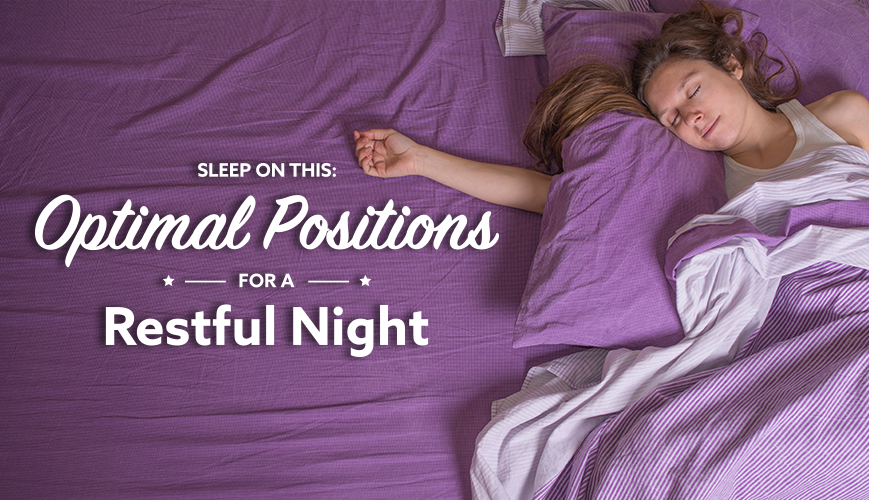Sleep on This: Optimal Positions for a Restful Night
By Dr. Molly Casey

Does how you sleep matter? When I say how you sleep, in context to this question, I mean your positioning; are you on your back, your side or your stomach? All else being equal, does the position you sleep in matter with regard to the health of your spine and your overall health? The answer is a resounding YES! It is estimated that we spend about one-third of our lives in bed, so considering our position while we sleep and how it affects the spine is important.
Ideal Sleeping Positions
Ultimately, the ideal sleeping position is one in which the spine is totally neutral. This means that the natural curves of the spine are supported with ease and there is no increased extension or flexion. With proper support, the ideal positions for sleeping are on the back or the side.
Back: While sleeping on your back, you want to make sure your neck is properly supported by a pillow that has a divot, or sunken area, for the head which creates a curve for your neck to rest on. This supports the proper cervical curve in a neutral position. Properly supporting the lumbar spine (your lower back), it’s ideal to put a pillow under your knees approximately two fist widths in depth.
Side: If you are a side sleeper, you also want to make sure the neck is properly supported with the guidelines listed above. While sleeping on your side with your knees touching, the SI (sacroiliac) joint on the side that’s up is gapped for the length of your sleep. While the gaping isn’t necessarily unnatural, it is when done for prolonged periods. The way to properly support the SI joint is to put a pillow between your knees for the night. The pillow should be the depth of approximately one fist width. When you’re sleeping on your side, be careful not to bring your knees up too high toward the chest because that simulates sitting, and you most likely do enough of that during your day!
The Worst Sleeping Position
I’m sure you’ve guessed by now that the worst sleeping position is the stomach. I know that all you stomach sleepers are saying, “but I absolutely can’t fall asleep or stay asleep on my back or side.” Believe me, I know. Once upon a time, I was one of you. Some experts think there is an emotional component to sleeping on the stomach because most stomach sleepers insist they can’t relax enough to sleep any other way.
What does sleeping on your stomach do and why is it so bad for you? The first reason is that because your neck needs to be turned to one side or the other, your cervical spine is severely stressed. The natural curve is not supported. Even more detrimental than that is the prolonged torque the cervical spine is under due to the head being turned for hours. When this occurs, the nervous system -- which is protected by the spine and is responsible for every function in your body -- is stressed because of the prolonged mechanical stress of the spinal structure.
The second reason is because the lumbar spine is in prolonged hyperextension, meaning the natural curve is exaggerated for long periods. Prolonged mechanical stress creates subluxations, which are joint restrictions or misalignments of the vertebrae. These joint restrictions irritate the nerves and, when the nervous system is stressed, you don’t function as well as you could or should. Your health is less than optimal.
Switching
So how do you switch from being a stomach sleeper to snoozing on your side or back? I hate to break it to you, but in all my years of experience, patients struggle most frequently with this particular habit shift. It can be done. I promise. As I’ve said, I used to be a stomach sleeper myself, once upon a time. My tips are this: If you sleep next to someone, tell them to nudge you every time they see you on your stomach. If you don’t sleep next to someone -- don’t laugh, I’ve had patients who’ve done this and it works -- sleep with a tennis ball. Put a tennis ball in a sock and sew the sock to the front of an old T-shirt; wear the T-shirt to bed repeatedly until turning over onto a tennis ball breaks the habit for you. It will eventually. Also, try a pillow on top of your chest while trying to fall asleep on your back. The compression from the pillow is often enough to help one relax enough to fall asleep.
There you have it -- the reasons your sleeping position matters to your health and what you can do to improve it. And know that if you’re a stomach sleeper, it’s all that much more important we see you at The Joint Chiropractic to get checked and adjusted for subluxations!
The information, including but not limited to, text, graphics, images and other material contained on this page are for informational purposes only. The purpose of this post is to promote broad consumer understanding and knowledge of various health topics. It is not intended to provide or be a substitute for professional medical advice, diagnosis or treatment. Always seek the advice of your chiropractor, physician or other qualified health care provider with any questions you may have regarding a medical condition or treatment and before undertaking a new health care regimen, and never disregard professional medical advice or delay in seeking it because of something you have read on this page.